Historical Thinking & Evaluation strategies

Historical Thinking Skills & Evaluation Strategies in Social Sciences
Historical thinking is a framework that allows students to explore the nature of history and historical events at a deeper level. Students actively investigate their past, using various intellectual operations, through an examination of source documents, and through a process of representation, rigorous reasoning, and interpretation.
Opportunities for formative and self-assessment abound. The Historical Thinking concepts and specific guideposts can help you note and then teach the more specific and deeper skills needed for final assessments. Here you will find notions, tools and strategies to help you teach critical thinking and more effectively use the evaluation frameworks and the "Intellectual Operations".
Note: Some of the actual Practice Evaluations produced by the RECITUS have been translated as well, and are available here below and on the main History of Quebec & Canada page here.
Intellectual Operations Video Capsules (EMSB)
View this series of six video capsules, designed to help Social Science teachers acquire a deeper understanding of the Intellectual Operations.
Thanks to Andrew D'Anna, Consultant at English Montreal School Board, and his team. These capsules were inspired by the research of Dr. Catherine Duquette (UQAC), Dr. Nicole Monney (UQAC), Dr. Sylvie Fontaine (UQO), and Laurie Pageau (PhD candidate, ULaval).
1.  An Introduction to the Intellectual Operations
An Introduction to the Intellectual Operations
3.  Identify Similarities & Differences
Identify Similarities & Differences
4.  Determine Causes & Consequences
Determine Causes & Consequences
5.  Determine Changes & Continuities
Determine Changes & Continuities
Intellectual Operations Icons, Summary Pages, Organizers
Intellectual Operations Icons by LEARN
Also, available are various "Summary Pages" and Related Graphic Organizers
Below you will now find our icons, which were originally used for summary pages created by LEARN and LBPSB consultants, and which now include the latest versions specific to the History of Quebec and Canada program. Older IO documents for courses being changed or discontinued may also be available.
A note about these icons from Paul R @ LEARN!
These icons have a story: They were quickly created when I was putting together various LESs and document packages, and when I was teaching the course myself online. The intention was to have identifiable iconography so that I could label activities easily and so students could readily see which operation they were performing. I created poster-sized versions to put on my wall as well. They quickly became very popular amongst teachers and students, and are now often used in the creation of materials by various boards and even on some exams! However, please note that they are not official documents, but are reflections on the official documents available on the MEES sites and on their training documents.
Summary documents of the frameworks and I.O.s
for various subjects within the Social Sciences:
Secondary History (HCE): Cycle 1 and 2 Download![]()
Secondary Geography Download![]()
Contemporary World: Download![]()
Histoire et éducation à la citoyenneté (1 et 2) Download![]()
Géographie Download![]()
Monde contemporain Download
Icon collections for the I.O.'s for older HCE:
Tabloid-sized for posters, in English Download![]() en français Download
en français Download
Secondary 3 and 4 History of Quebec program icons:
Tabloid and small jpeg versions together Download![]()
Card-sized versions for activities Go to site![]()
Tabloid et petit jpgs en français Download![]()
GRAPHIC ORGANIZER COLLECTIONS
Visit our central store-house for various graphic organizers, many of which were developed for the myriad learning scenarios and document packages on LEARN. For convenience, we have gathered them together, and to loosely organize them around various Historical Thinking concepts, their guideposts document, and our own program's Intellectual Operations. Go to page![]()
Intellectual Operation (I.O.) Guides and Badges by RECITUS
Earning your Intellectual Operations Badges by RECITUS
Below are a series of badges for the I.O.s in history and geography that you can hand over to students as they practice the operations, and as they become proficient in using them in different situations. They were originally prepared by the RECITUS team. Their French versions are now available via Go to site![]()
Notes about these guides and in particular the use of badges. While they do allow the teacher or student to illustrate concretely an abstract intellectual operation, they are not instruments of evaluation. Rather, they might help students assess where they are in their appropriation of one or other of the intellectual operations. Finally, they could also be used as tools to inspire and motivate students, in gaming strategies in class, a playful learning tool, or as just one teaching medium among many others. It is up to teachers to define an appropriate distribution system.
Also note that the separate English badge images used in the guides are available here: Download![]()
New for 2021: Elementary-level badge guides with additional sample worksheets are now available on the Societies and Territories web site. Go to site![]()
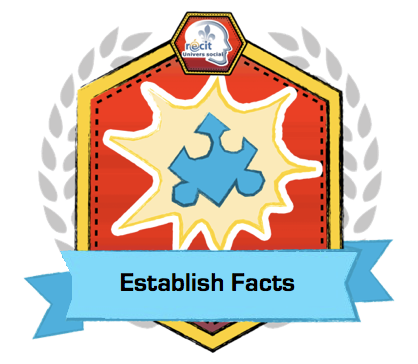 Establish Facts
Establish Facts
The student must identify an actor, a group, an action, a measure, a role, a territory, an economic activity, a phenomenon.
Download English secondary version of the guide, several worksheets, as Google Slides: Go to site![]()
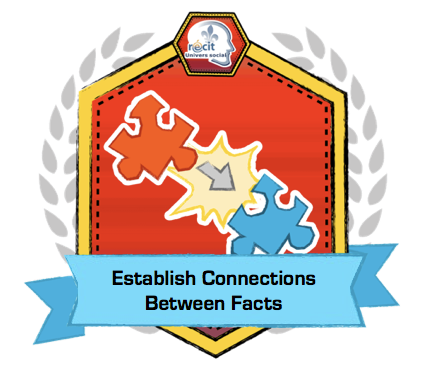
Establish connections between facts
The student must associate demonstrations or descriptions with facts that are related to them.
Access current English version Go to site![]()
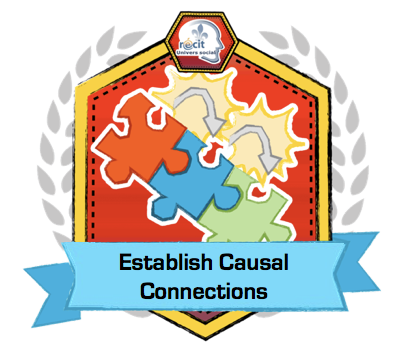
Establish Causal Connections
The student must demonstrate the causal link between the specified elements.
Access current English version Go to site![]()
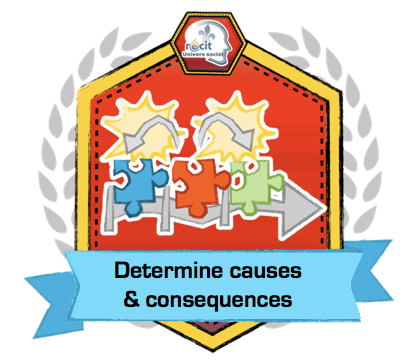
Determine causes & consequences
The student should indicate a fact, for example, the contexts, interests, objectives, influences, actions, which explains a historical reality. The student should indicate a fact that springs from a historical reality.
Access current English versions:
Causes Go to site![]() Consequences Go to site
Consequences Go to site![]()
Situate in Time
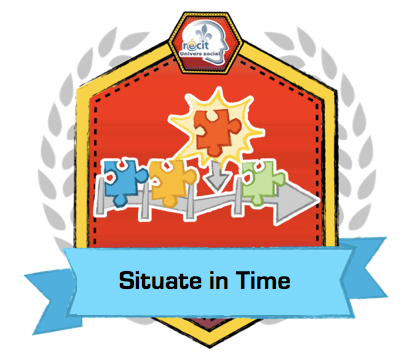 The student must chronologically order facts taking into account time markers. It must situate a fact or set of facts on a timeline. It must classify facts according to whether they are earlier or later than a time marker.
The student must chronologically order facts taking into account time markers. It must situate a fact or set of facts on a timeline. It must classify facts according to whether they are earlier or later than a time marker.
Download English Google Doc secondary example Go to site![]()

Situate in Space
The student must situate geographical elements, facts or territories in space.
Guide to come.
Download English Google Doc example Go to site![]()

Identify differences & similarities
Students should identify differences and similarities or points of convergence or divergence.
Access current English versions:
Convergence & divergence Go to site![]()
Similarities & Differences Go to site![]()

Determine changes & continuities
The student must identify a fact that shows that a historical reality is being transformed or maintained.
Access current English version: Changes and continuities Go to site![]()
HQC Evaluation Materials and Grids
RECITUS Questions and Evaluations in English
Occasionally we translate RECITUS document collections, tasks and most recently some of their evaluations. They are then stored on the Secondary 3/4 Communauté Histoire du Québec et du Canada. (Go to site![]() ) Direct links to these resources are below.
) Direct links to these resources are below.
SECONDARY 3:
Review with BANQ Short Answer Questions - Origins to 1840 Go to site![]()
Review Slides (Synthesis for Origins to 1840) Go to site![]()
Question developing of a coherent representation of a period C1 - Origins -1608 Go to site![]()
Question demonstrating rigour of interpretation C2 - Origins to 1608 Go to site![]()
Question demonstrating rigour of interpretation C2 - 1608-1760 Go to site![]()
Question developing a coherent representation of a period C1 - 1608 to1663 Go to site![]()
Question developing a coherent representation of period C1 - 1763-1774 Go to site![]() Question demonstrating rigour of interpretation C2 1760-1791 Go to site
Question demonstrating rigour of interpretation C2 1760-1791 Go to site![]()
Question developing a coherent representation of a period C1 - 1791-1840 Go to site![]()
Question demonstrating rigour of interpretation C2 - 1791-1840 Go to site![]()
SECONDARY 4:
Short-answer review questions - period 1840 to the present Go to site![]()
Short Answer Questions -- 1945-1980 Go to site![]()
Short questions - Period of 1980 to our times Go to site![]()
Question developing a coherent representation of a period C1 - 1840 to 1896 Go to site![]()
Question developing a coherent representation of a period C1 - 1896 to 1945 Go to site![]()
Question developing a coherent representation of a period C1 - 1945 to 1980 Go to site![]()
Question developing a coherent representation of a period C1 - 1980 to today Go to site![]()
Question demonstrating rigour of interpretation C2 - 1840 to 1896 Go to site![]()
Question demonstrating rigour of interpretation C2 - 1896 à 1945 Go to site![]()
Question demonstrating rigour of interpretation C2 - 1945 to 1980 Go to site![]()
Question demonstrating rigour of interpretation C2 - 1980 to today Go to site![]()
CSMV (Robillard & Quirion): Duplessis- modernism ou conservatism ? C2 - Question demonstrating rigour of interpretation Go to site![]()
SWLSB database of exam questions
Recently shared on the community by Daniel Hedges, a consultant at SWLSB, is a large project whereby recycled and recently created MEES-style exam questions have been organized according to course time periods. The links below lead directly to the questions posted to the Secondary 3/4 Communauté Histoire du Québec et du Canada.
 Secondary 3
Secondary 3
Question Database: Origins to 1608 ![]()
Question Database: 1608-1760![]()
Secondary 4
Question Database: 1840-1896![]() .
.
Question Database: 1896-1945![]()
Note: These are links midway to sections in rather long documents. Scan all the way to the bottom for extra exams and resources. ;-)
Newly created Dec. 2019 - Quick links to questions!
With these quick links, you have access to Document Based Questions by topic. Since the topics are laid out for each time period, this resource works well for practicing Document Base Questions with students thoughout the year, on a ongoing basis, and as a routine. This helps students get better at Document Based Questions, and ultimately to be better prepared for the exam too!! (D. Hedges)
Click to access the new SEC. 3 and SEC. 4 Quick Links document![]()
Evaluation Grids: Assessment of Intellectual Operations
Elementary
Visit the Societies and Territories site here to find various I.O. guides and now also English versions of the RECITUS Elementary Grilles d’évaluation (here in French).
Secondary
New: Secondary versions of thos same RECITUS Grilles d’évaluation are now available in English too! Visit the Translated Evaluation Grids for IO's shared by LBPSB!
MEQ (Previously MEES) Program Documents - Secondary
Below you will find various Ministry of Education program and evaluation documents for the Secondary Social Sciences domain. (Contact Paul R. if you find broken links!)
Quebec Secondary Programs in Social Sciences
The QEP program documents describe course aims, competencies to develop, and course content.
Cycle 1 History and Citizenship Education Download![]()
Cycle 1 Geography Program Go to site![]() Download
Download![]()
Cycle 2 History of Quebec and Canada Sec. 3 & 4 program Download![]()
Cycle 2 History of the 20th Century Download![]()
Cycle 2 Cultural Geography Download![]()
Cycle 2 Financial Education Program Download![]()
Cycle 2 Contemporary World Go to site![]() (Or view PDFs for Four credits
(Or view PDFs for Four credits![]() Two credits
Two credits![]()
Note that the Ministry (MEES) Programs of Study page, where you will find these "General Education" Secondary School Programs and older programs too, is now online here: Go to site![]()
Progression/Precision of Learning documents
Cycle 1 History & Citizenship Go to site![]()
Cycle 1 Geography Go to site![]()
Cycle 2 Contemporary world Go to site![]() (Or view PDF's for Four credits or Two credits)
(Or view PDF's for Four credits or Two credits)
History of Quebec & Canada. (See instead "knowledge" within the program Download![]() )
)
Evaluation Frameworks
Below are links to the individual evaluation frameworks. You can also visit the main MEES site and browse by subject to review them Go to site![]()
Cycle 1 and 2 - History & Citizenship Education Download![]()
Cycle 2 (New) History of Québec and Canada program Download![]()
(Older) History & Citizenship Education framework Download![]()
Cycle 1 Geography framework Go to site![]() (Or Download
(Or Download![]() )
)
Contemporary World online version Go to site![]() (Or Download
(Or Download![]() )
)
Financial Education Go to site![]() (Or Download
(Or Download![]() )
)
BAMD: MEES approved books site
Bureau d'approbation du matériel didactique
MEES sample "Document files" from training sessions
1608 and 1760 - Document File: Cities in Canada
1840-1896 - Document File: Socio-cultural expression
1896 to 1945 - Document File: Education and technical training
1896-present - Document File: Challenging capitalism
1945-present - Document file: Language issue
1980-present - Document File: Information Era
Origins to present - Document File: Inuit nation
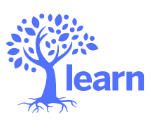



 FACEBOOK
FACEBOOK TWITTER
TWITTER
 INSTAGRAM
INSTAGRAM LINKEDIN
LINKEDIN